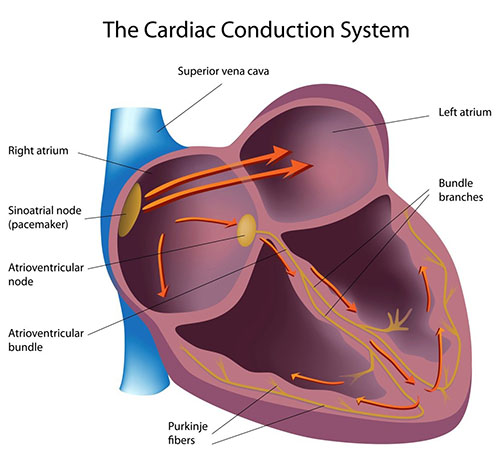Normal Heart Rhythm: How Your Heart Beats
The heart is a muscle that pumps blood through its four chambers: two upper chambers called the atria and two lower chambers called the ventricles. These chambers contract in a carefully organized sequence, which is regulated by the heart’s electrical system.
Atria and Ventricles are separated by heart valves that are meant to allow blood to only flow forward. The ventricle is the more muscular part of your heart and responsible for over 80% of the blood flow. The atria are thinner, but also very important to help with blood flow.
The Electrical System of the Heart
Your heart’s electrical signals ensure the coordinated contractions that make up a healthy heartbeat. Here’s how it works:
The atria and ventricles contract in an organized sequence which is very efficient. That sequence is controlled by the electrical system of the heart: the sinus node, AV node and His-Purkinje system.

The heart has 4 chambers: right and left atria and the right and left ventricles. The Cardiac Conduction System makes the heart muscle contract in an organized and efficient fashion.
The Electrical System of the Heart
Sinus Node
Your heart has a specialized electrical system that essentially tells the muscle when to beat or contract. The electrical impulse begins in the Sinus node. The Sinus node is located in the right atrium, and is your own natural pacemaker – telling the heart when it is time to beat. It controls the rate and increases it as needed – for example during exercise.
When your heart is in normal rhythm, it is called sinus rhythm because the sinus node is controlling when each heart beat is going to happen.
After the Sinus node start the contraction in the right atrium, the electrical activity travels through the right and left atrium causing that part of the heart to contract, pushing blood forward, into the right and left ventricles.
The atria is not nearly as important as the ventricle in terms of heart pumping function. However, it is very important in regulating the normal heart rhythm (via the sinus node). The atria is also the origin of many heart rhythm disorders, such as atrial fibrillation or other so called supraventricular arhythmias.
Atrio-ventricular Node (AV Node)
After the activity starts in the sinus node it goes into the AV node. The AV node is best described as a wire that connects the upper and lower chambers, sending the electrical impulse that started in the sinus node into the ventricle, telling it to contract.
His-Purkinje System
The impulse then travels from the AV node via specialized cells that act as wires that will send the signal to contract to the right and left ventricles.
The Normal Heart Rhythm
When the Normal Sequence Is Followed
- Impulse originates in the sinus node and quickly spreads into the right and left atria
- Atria will contract causing blood to flow into the ventricles
- The electrical impulse will go through the AV node, which causes a small delay, allowing the ventricles to fill with more blood
- Electrical impulses are then conducted quickly via the His-Purkinje system into the entire right and left ventricles
- As the electrical impulses reach the heart muscle, the right and left ventricles will contract
- When the ventricles contract the mitral and tricuspid valves will close causing the blood to be ejected forward, into your lungs or your body.
Disruptions in this process can lead to arrhythmias like atrial fibrillation (AFib), which can cause irregular heartbeats and increase the risk of stroke.
For more information on how we treat rhythm disorders, visit our AFib Treatment Options and AFib Ablation pages.
Dr Jose Osorio
Miami, FL
Read More About AFib:
AFib Ablation: Advanced Atrial Fibrillation Treatment in Miami | The AFib Clinic
